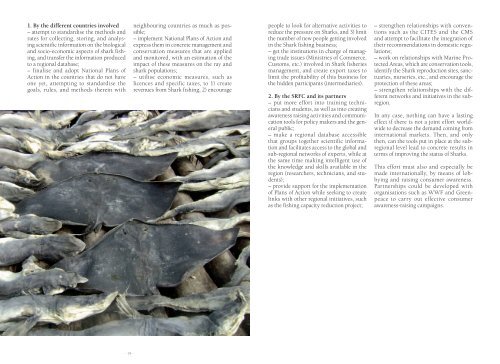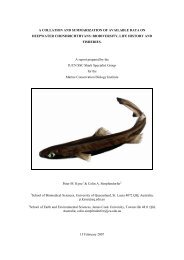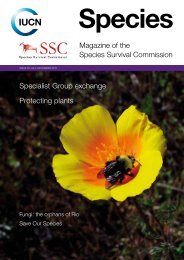30 Years of shark fishing in west africa - Shark Specialist Group
30 Years of shark fishing in west africa - Shark Specialist Group
30 Years of shark fishing in west africa - Shark Specialist Group
You also want an ePaper? Increase the reach of your titles
YUMPU automatically turns print PDFs into web optimized ePapers that Google loves.
1. By the different countries <strong>in</strong>volved<br />
– attempt to standardise the methods and<br />
rates for collect<strong>in</strong>g, stor<strong>in</strong>g, and analys<strong>in</strong>g<br />
scientific <strong>in</strong>formation on the biological<br />
and socio-economic aspects <strong>of</strong> <strong>shark</strong> <strong>fish<strong>in</strong>g</strong>,<br />
and transfer the <strong>in</strong>formation produced<br />
to a regional database;<br />
– f<strong>in</strong>alise and adopt National Plans <strong>of</strong><br />
Action <strong>in</strong> the countries that do not have<br />
one yet, attempt<strong>in</strong>g to standardise the<br />
goals, rules, and methods there<strong>in</strong> with<br />
neighbour<strong>in</strong>g countries as much as possible;<br />
– implement National Plans <strong>of</strong> Action and<br />
express them <strong>in</strong> concrete management and<br />
conservation measures that are applied<br />
and monitored, with an estimation <strong>of</strong> the<br />
impact <strong>of</strong> these measures on the ray and<br />
<strong>shark</strong> populations;<br />
– utilise economic measures, such as<br />
licences and specific taxes, to 1) create<br />
revenues from <strong>Shark</strong> <strong>fish<strong>in</strong>g</strong>, 2) encourage<br />
people to look for alternative activities to<br />
reduce the pressure on <strong>Shark</strong>s, and 3) limit<br />
the number <strong>of</strong> new people gett<strong>in</strong>g <strong>in</strong>volved<br />
<strong>in</strong> the <strong>Shark</strong> <strong>fish<strong>in</strong>g</strong> bus<strong>in</strong>ess;<br />
– get the <strong>in</strong>stitutions <strong>in</strong> charge <strong>of</strong> manag<strong>in</strong>g<br />
trade issues (M<strong>in</strong>istries <strong>of</strong> Commerce,<br />
Customs, etc.) <strong>in</strong>volved <strong>in</strong> <strong>Shark</strong> fisheries<br />
management, and create export taxes to<br />
limit the pr<strong>of</strong>itability <strong>of</strong> this bus<strong>in</strong>ess for<br />
the hidden participants (<strong>in</strong>termediaries).<br />
2. By the SRFC and its partners<br />
– put more effort <strong>in</strong>to tra<strong>in</strong><strong>in</strong>g technicians<br />
and students, as well as <strong>in</strong>to creat<strong>in</strong>g<br />
awareness rais<strong>in</strong>g activities and communication<br />
tools for policy makers and the general<br />
public;<br />
– make a regional database accessible<br />
that groups together scientific <strong>in</strong>formation<br />
and facilitates access to the global and<br />
sub-regional networks <strong>of</strong> experts, while at<br />
the same time mak<strong>in</strong>g <strong>in</strong>telligent use <strong>of</strong><br />
the knowledge and skills available <strong>in</strong> the<br />
region (researchers, technicians, and students);<br />
– provide support for the implementation<br />
<strong>of</strong> Plans <strong>of</strong> Action while seek<strong>in</strong>g to create<br />
l<strong>in</strong>ks with other regional <strong>in</strong>itiatives, such<br />
as the <strong>fish<strong>in</strong>g</strong> capacity reduction project;<br />
– strengthen relationships with conventions<br />
such as the CITES and the CMS<br />
and attempt to facilitate the <strong>in</strong>tegration <strong>of</strong><br />
their recommendations <strong>in</strong> domestic regulations;<br />
– work on relationships with Mar<strong>in</strong>e Protected<br />
Areas, which are conservation tools,<br />
identify the <strong>Shark</strong> reproduction sites, sanctuaries,<br />
nurseries, etc., and encourage the<br />
protection <strong>of</strong> these areas;<br />
– strengthen relationships with the different<br />
networks and <strong>in</strong>itiatives <strong>in</strong> the subregion.<br />
In any case, noth<strong>in</strong>g can have a last<strong>in</strong>g<br />
effect if there is not a jo<strong>in</strong>t effort worldwide<br />
to decrease the demand com<strong>in</strong>g from<br />
<strong>in</strong>ternational markets. Then, and only<br />
then, can the tools put <strong>in</strong> place at the subregional<br />
level lead to concrete results <strong>in</strong><br />
terms <strong>of</strong> improv<strong>in</strong>g the status <strong>of</strong> <strong>Shark</strong>s.<br />
This effort must also and especially be<br />
made <strong>in</strong>ternationally, by means <strong>of</strong> lobby<strong>in</strong>g<br />
and rais<strong>in</strong>g consumer awareness.<br />
Partnerships could be developed with<br />
organisations such as WWF and Greenpeace<br />
to carry out effective consumer<br />
awareness-rais<strong>in</strong>g campaigns.<br />
- 74 -
















